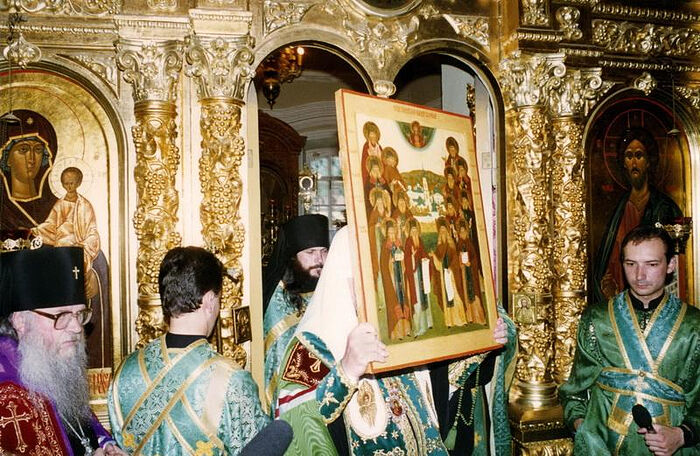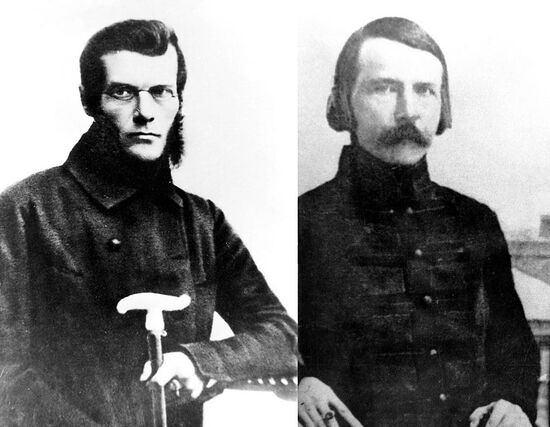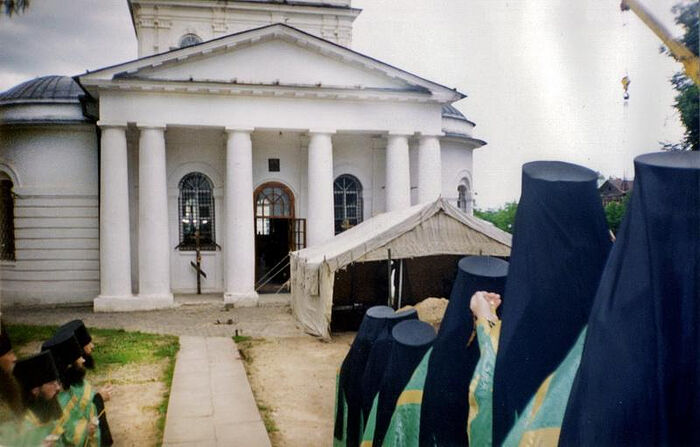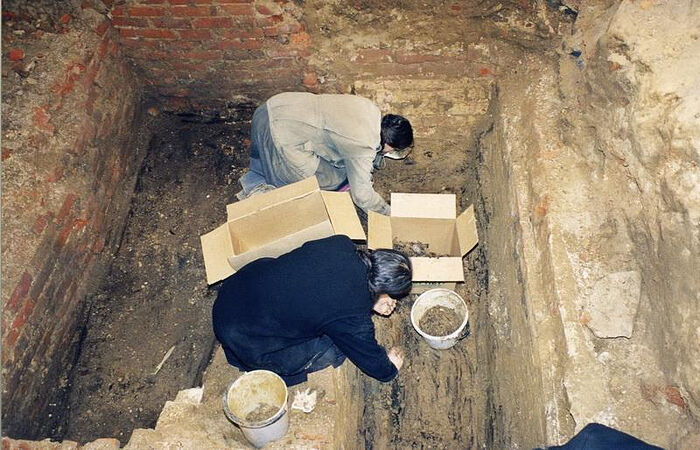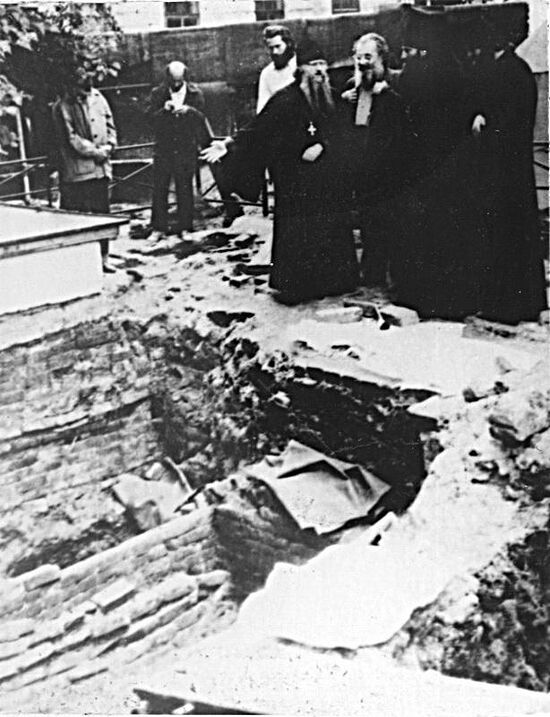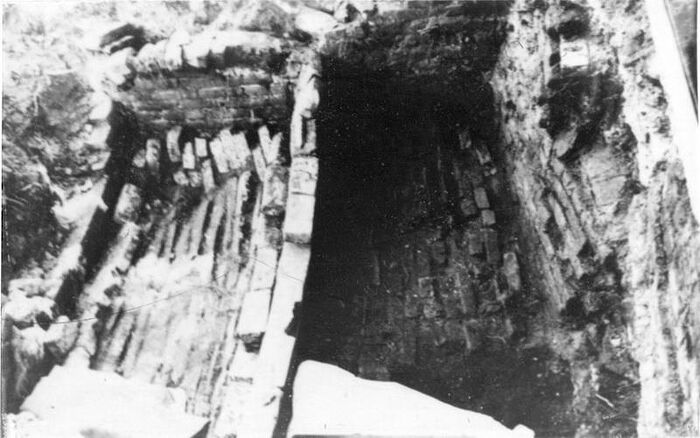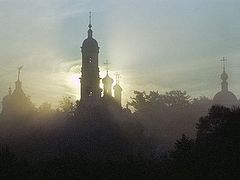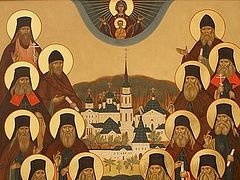On June 27/July 10, the Church celebrates the 1998 Uncovering of the Relics of the Optina Elders Leo, Macarius, Hilarion, Ambrose, Anatoly (Zertsalov), Barsanuphius, and Anatoly (Potapov). The Optina Monastery website tells the interesting story of how the relics were uncovered and identified.—Trans.
The canonization of the Synaxis of the Optina Elders, which took place on July 26, 1996, filled the life of the Optina Entrance of the Theotokos Monastery with a new sublimity. Under the prayerful protection of the newly-glorified saints, Optina continued to rise from the ruins, and the stream of pilgrims to this ancient monastery grew day by day. Many who visited the monastery necropolis—the place of the burial of seven of the holy Optina Elders—tireless intercessors for the monastery, the Church, and the Fatherland—had the thought that the holy relics of these God-pleasers should rest not under the open sky, but in a church of God, where their grace-filled presence and prayerful help would be more palpable.
At one time, deep love and reverence for the Elders prompted the monastery brethren to erect chapels at their burial sites, and they even planned to build a special permanent structure. But the terrible bloody years had left only ruins in the monastery, making it difficult to even find the Elders’ graves.
In 1987, Optina was reopened, and the first task was to beautify the holy graves of the Elders, removing all traces of profanation.
When work began on the reconstruction of the Church of the Vladimir Icon of the Mother of God, His Holiness Patriarch Alexei of Moscow and All Russia, who was the head of the Stavropegial Optina Hermitage, gave his blessing to build it such that it would become the crypt of the seven Optina Elders buried in the monastery necropolis. And so, the summer of 1998 was also marked by a joyous event, with the successful completion of the construction of the church. On June 24, His Holiness gave his blessing to uncover the holy relics, and on July 7, on the feast of the Nativity of the Honorable, Glorious Prophet, Forerunner, and Baptist of the Lord John, after a moleben to the Synaxis of the Optina Elders, work on the monastery necropolis began.
At first, it was proposed to work on finding the holy relics of four Elders: Leo, Macarius, Anatoly (Zertsalov), and Barsanuphius. But it so happened that after two and a half days, the relics of all seven Elders were uncovered.
Below are presented photographs from the Optina archives, as well as chronicles and published materials that reveal the history of the graves of the section of the necropolis where the Optina Elders were buried. There are also modern photographs showing the main points in the process of uncovering the relics of the seven Elders: Leo, Macarius, Ambrose, Hilarion, Anatoly (Zertsalov), Barsanuphius, and Anatoly (Potapov).
The graves of the venerable Elders
On the grave of Elder Leo (Nagolkin)
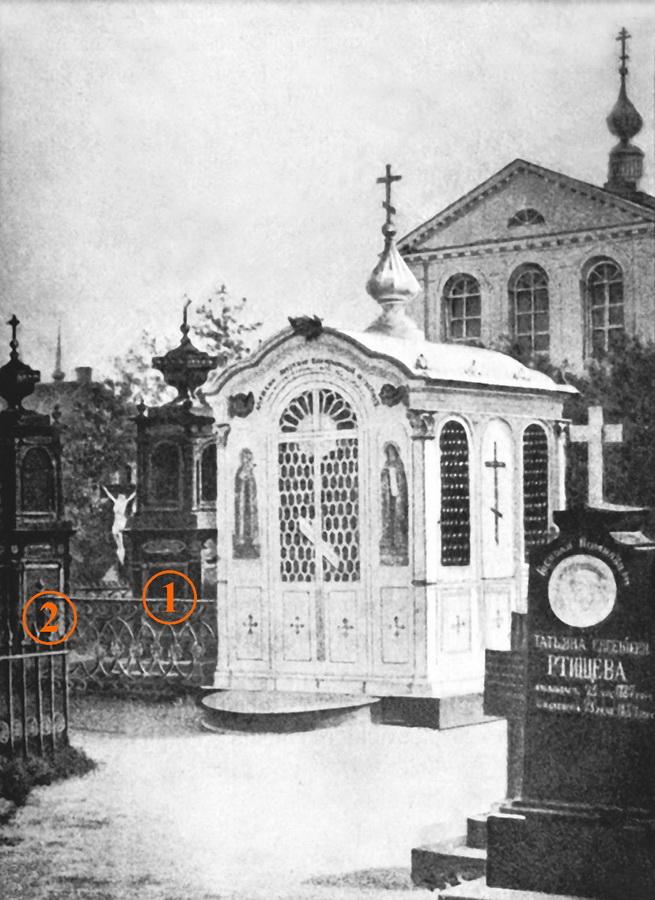 The original view of the burial site of Elder Leo: (1) monument on the grave of Elder Leo; (2) the same monument on the grave of Alexei Zhelyabuzhsky
The original view of the burial site of Elder Leo: (1) monument on the grave of Elder Leo; (2) the same monument on the grave of Alexei Zhelyabuzhsky
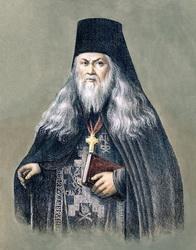 “The body of Elder Leonid [named Leo in the schema—Trans.] was buried, according to the common desire of the abbot and brethren, near the Entrance of the Theotokos Cathedral, behind the southern altar dedicated to St. Nicholas the Wonderworker, next to the grave of his spiritual son and friend in the Lord Alexei Ivanovich Zhelyabuzhsky, who reposed several months before Fr. Leonid, on June 11 of the same year, 1841. During his lifetime, Fr. Leonid as if jokingly used to say to him: ‘Elder! You and I will lie next to each other, side by side.’ These words of Fr. Leonid were recalled after his burial, and people were amazed at how precisely they came true.” (Life of Hieroschemamonk Leo, Optina Monastery, 1994)
“The body of Elder Leonid [named Leo in the schema—Trans.] was buried, according to the common desire of the abbot and brethren, near the Entrance of the Theotokos Cathedral, behind the southern altar dedicated to St. Nicholas the Wonderworker, next to the grave of his spiritual son and friend in the Lord Alexei Ivanovich Zhelyabuzhsky, who reposed several months before Fr. Leonid, on June 11 of the same year, 1841. During his lifetime, Fr. Leonid as if jokingly used to say to him: ‘Elder! You and I will lie next to each other, side by side.’ These words of Fr. Leonid were recalled after his burial, and people were amazed at how precisely they came true.” (Life of Hieroschemamonk Leo, Optina Monastery, 1994)
On the grave of Elder Macarius (Ivanov)
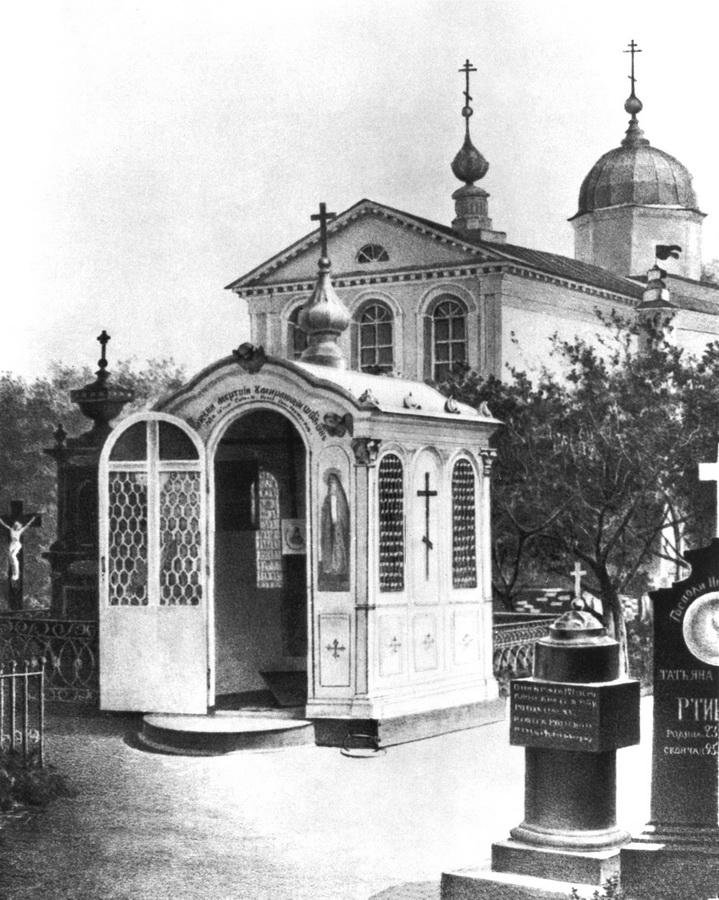 Chapel on the site of the burial of Elder Macarius
Chapel on the site of the burial of Elder Macarius
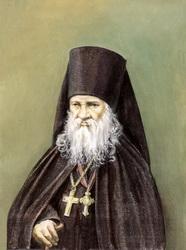 “At two o’clock in the afternoon, the body of the one who had reposed in the Lord was transferred from the skete church to the monastery church, where, by order of the abbot, a place was prepared for the deceased Elder at the right hand of his spiritual friend Hieroschemamonk Leonid.
“At two o’clock in the afternoon, the body of the one who had reposed in the Lord was transferred from the skete church to the monastery church, where, by order of the abbot, a place was prepared for the deceased Elder at the right hand of his spiritual friend Hieroschemamonk Leonid.
“… Finally, the coffin was lowered into the grave prepared across from the St. Nicholas altar of the cathedral church, on the right side of the crypt, where lies the body of Hieroschemamonk Leonid (Leo), the Elder’s spiritual friend and co-laborer.” (Life of Hieroschemamonk Macarius, Optina Monastery, 1995)
On the grave of Elder Hilarion (Ponomarev)
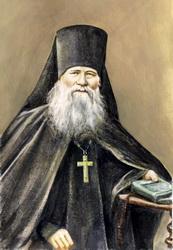 There are no photos or drawings showing the burial place of St. Hilarion of Optina.
There are no photos or drawings showing the burial place of St. Hilarion of Optina.
St. Hilarion bore the podvig of eldership with great selflessness. The Elder overcame his most difficult, painful, and lasting illness until his last breath by great love for God and man. The brethren’s reciprocal love for St. Hilarion was expressed in the fact that he was buried near the graves of his famous predecessors, Sts. Leo and Macarius. Additionally, a hospital church was built beyond the south wall of the monastery in his memory, dedicated to St. Hilarion the Great, whose name he bore.
“After the funeral service, the monastic brethren and the laity offered their last farewell to the Elder, and then the body of the deceased was given over to the earth near the grave of Elder Macarius, across a path a fathom wide, in a special crypt.
“… On September 29, by the care of the treasurer Fr. Flavius, in anticipation of the future monument over the grave of Fr. Hilarion, a space was left behind glass for the crucifixion, with a lampada burning unceasingly in front of it.” (Life of Hieroschemamonk Hilarion, Optina Monastery, 1995)
There was no chapel of St. Ambrose between the Chapel of Elder Macarius and the grave of Elder Hilarion at that time, as St. Ambrose reposed eighteen years after Elder Hilarion.
On the grave of Elder Ambrose (Grenkov)
 The original appearance of the burial site of three of the Elders: (1) chapel over the grave of Elder Macarius; (2) chapel over the grave of Elder Ambrose; (3) grave of Elder Joseph
The original appearance of the burial site of three of the Elders: (1) chapel over the grave of Elder Macarius; (2) chapel over the grave of Elder Ambrose; (3) grave of Elder Joseph
 “Those who have visited the Optina Hermitage undoubtedly remember near the southeastern wall of the summer Entrance of the Theotokos Cathedral, to the left of the path, a white chapel over the grave of Elder Macarius. Next to this chapel was prepared the grave of the newly-repose Elder Ambrose. After the memorial litiya, served by Vladyka, and after the proclamation of memory eternal to the deceased, the coffin was lowered into a box coated with pitch that was in the grave, which was then covered with a special lid.” (Life of the Venerable Elder Ambrose of Optina, Optina Monastery, 1997)
“Those who have visited the Optina Hermitage undoubtedly remember near the southeastern wall of the summer Entrance of the Theotokos Cathedral, to the left of the path, a white chapel over the grave of Elder Macarius. Next to this chapel was prepared the grave of the newly-repose Elder Ambrose. After the memorial litiya, served by Vladyka, and after the proclamation of memory eternal to the deceased, the coffin was lowered into a box coated with pitch that was in the grave, which was then covered with a special lid.” (Life of the Venerable Elder Ambrose of Optina, Optina Monastery, 1997)
On the grave of Elder Joseph (Litovkin)
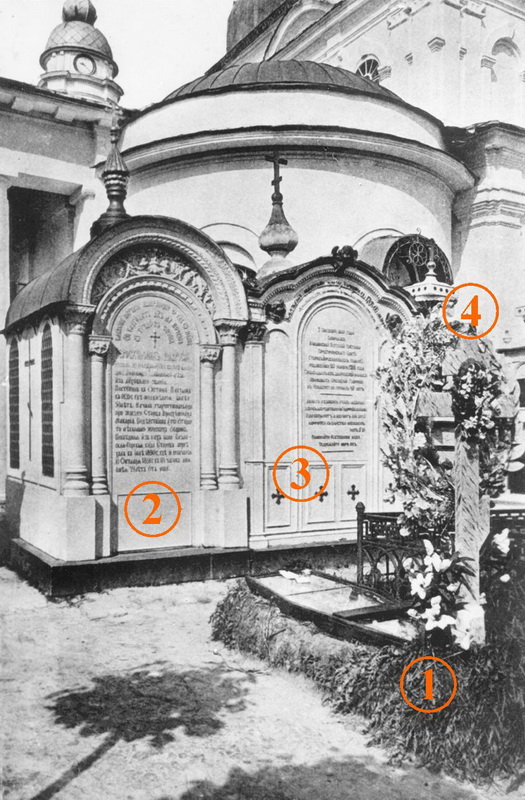 A view of the burial site of three Optina Elders: (2) St. Ambrose; (3) St. Macarius; (4) St. Leo. (1) indicates the site of the burial of Optina Elder Joseph.
A view of the burial site of three Optina Elders: (2) St. Ambrose; (3) St. Macarius; (4) St. Leo. (1) indicates the site of the burial of Optina Elder Joseph.
“At the grave, prepared at the feet of Elder Ambrose, the last litiya was served and the coffin was lowered into the crypt.” (Life of Hieroschemamonk Joseph, Optina Monastery, 1993).
On the grave of Elder Anatoly (Potapov)
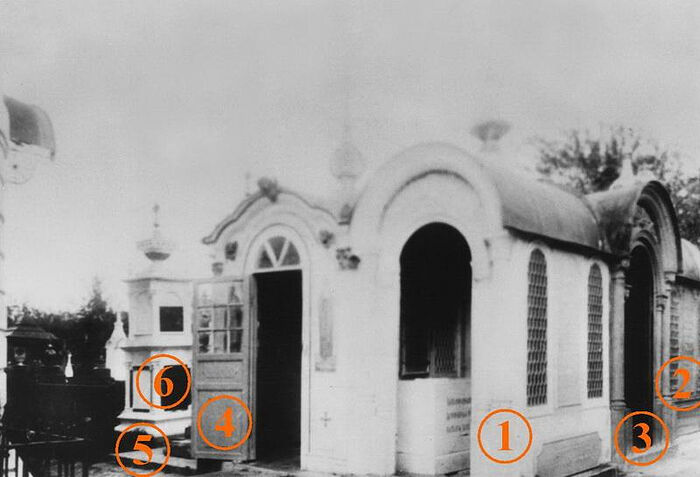 The burial site of Elder Anatoly (Potapov): (1) chapel over the grave of Elder Ambrose; (2) chapel over the grave of Elder Joseph, joined to the chapel of Elder Ambrose; (3) place of burial (in 1922) of Elder Anatoly, between the tombstones of Elder Ambrose and Elder Joseph; (4) chapel of Elder Macarius; (5) the edge of the cast-iron monument over the grave of Elder Leo can be seen; (6) cast-iron monument over the grave of A. Zhelyabuzhsky
The burial site of Elder Anatoly (Potapov): (1) chapel over the grave of Elder Ambrose; (2) chapel over the grave of Elder Joseph, joined to the chapel of Elder Ambrose; (3) place of burial (in 1922) of Elder Anatoly, between the tombstones of Elder Ambrose and Elder Joseph; (4) chapel of Elder Macarius; (5) the edge of the cast-iron monument over the grave of Elder Leo can be seen; (6) cast-iron monument over the grave of A. Zhelyabuzhsky
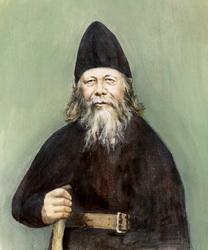 “The grave was prepared near the altar of the Entrance of the Theotokos Cathedral, in the same chapel were Elders Ambrose and Joseph were buried, on the very spot where Fr. Anatoly stood for two weeks until his repose. When they were digging the grave, they accidently hit the coffin of Elder Macarius. The body of the blessed Elder was incorrupt.” (Life of Hieroschemamonk Anatoly (Potapov), Optina Monastery, 1995)
“The grave was prepared near the altar of the Entrance of the Theotokos Cathedral, in the same chapel were Elders Ambrose and Joseph were buried, on the very spot where Fr. Anatoly stood for two weeks until his repose. When they were digging the grave, they accidently hit the coffin of Elder Macarius. The body of the blessed Elder was incorrupt.” (Life of Hieroschemamonk Anatoly (Potapov), Optina Monastery, 1995)
On the grave of Elder Anatoly (Zertsalov)
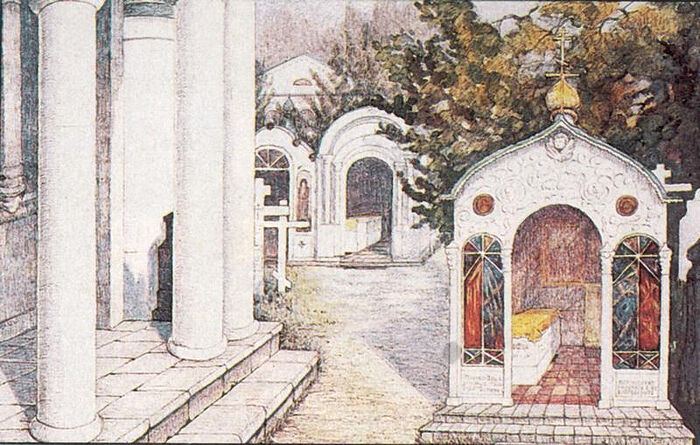 A drawing of the chapel over the graves of Elders Anatoly (Zertsalov) on the right and Barsanuphius on the left
A drawing of the chapel over the graves of Elders Anatoly (Zertsalov) on the right and Barsanuphius on the left
The following is known about the burial site of Elder Anatoly:
“They buried him between the Entrance of the Theotokos and the Kazan Cathedrals.” (Life and Teachings of Hieroschemamonk Anatoly (Zertsalov), Optina Monastery, 1994)
On the grave of Elder Barsanuphius (Plekhankov)
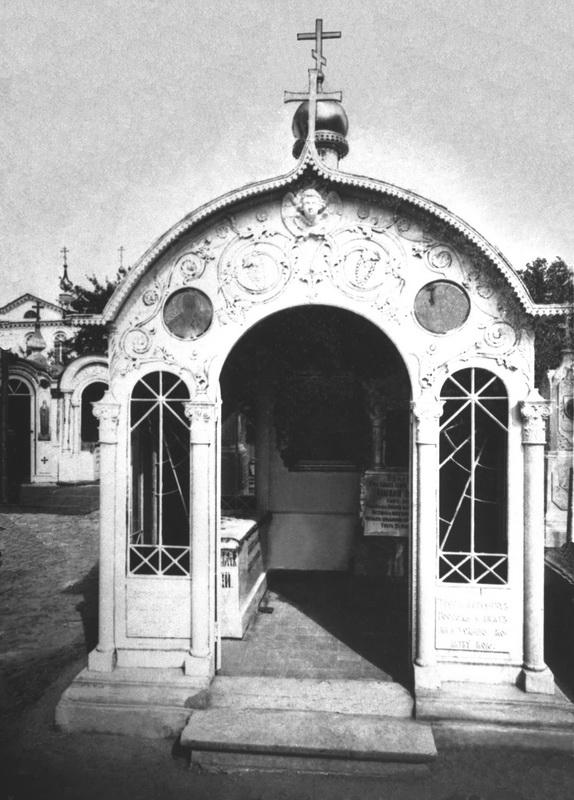 The chapel over the site of the burial of Elders Barsanuphius and Anatoly
The chapel over the site of the burial of Elders Barsanuphius and Anatoly
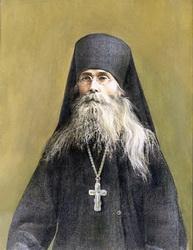 “To the singing of ‘Holy God’ and the ringing of the bells, the coffin of Elder Barsanuphius floated out of the church on the hands of the brethren—the funeral procession stopped at the south doors of the Entrance of the Theotokos Cathedral, where was the final resting place of Fr. Barsanuphius, next to Elder Anatoly, his mentor, beloved father, and guide.
“To the singing of ‘Holy God’ and the ringing of the bells, the coffin of Elder Barsanuphius floated out of the church on the hands of the brethren—the funeral procession stopped at the south doors of the Entrance of the Theotokos Cathedral, where was the final resting place of Fr. Barsanuphius, next to Elder Anatoly, his mentor, beloved father, and guide.
“Later, a common chapel for both Elders was built, with their tombstones located inside…” (Life of Schema-Archimandrite Barsanuphius, Optina Monastery, 1995)
The installation of the memorial chapel began on May 24, 1914, according to the Chronicle of the Skete.
About the grave of Ivan Kireevsky (1806-1856) and Peter Kireevsky (1808-1956)
 (1) Monument over the grave of Ivan Kireevsky; (2) monument over the grave of Elder Leo; (3) Chapel of Elder Macarius
(1) Monument over the grave of Ivan Kireevsky; (2) monument over the grave of Elder Leo; (3) Chapel of Elder Macarius
“To Ivan Vasilievich Kireevsky together with Elder Macarius belongs the initiative of a great undertaking—the publication of Patristic writings… He points out that Russian philosophy should be built upon the deep, living, and pure love of wisdom of the Holy Fathers, who represent the buds of higher philosophical analysis.
“Of all the laymen who went to the Optina Hermitage, Kireevsky came closer to its spirit than all the rest, and understood as none other its significance as a spiritual summit.
“Ivan Vasileevich died of cholera in St. Petersburg, where he had gone to visit his son, who graduated from the lyceum.”
“The collector of ancient spiritual poems, epics, and folk songs, Peter Vasilievich Kireevsky … a great admirer of ancient Rus’, a spiritual son of the Optina Elders … gave his entire life to the service of the idea of Holy Rus’.”
“Ivan Vasilievich Kireevsky and his brother Peter, together with Ivan’s wife Natalia Petrovna, are buried by the Entrance of the Theotokos Church at the Optina Hermitage, next to the graves of the great Elders Leonid (Leo in the schema), Macarius, and Ambrose.” (Optina Hermitage and Its Times, I. M. Kontsevich, Holy Trinity-St. Sergius Lavra, 1995)
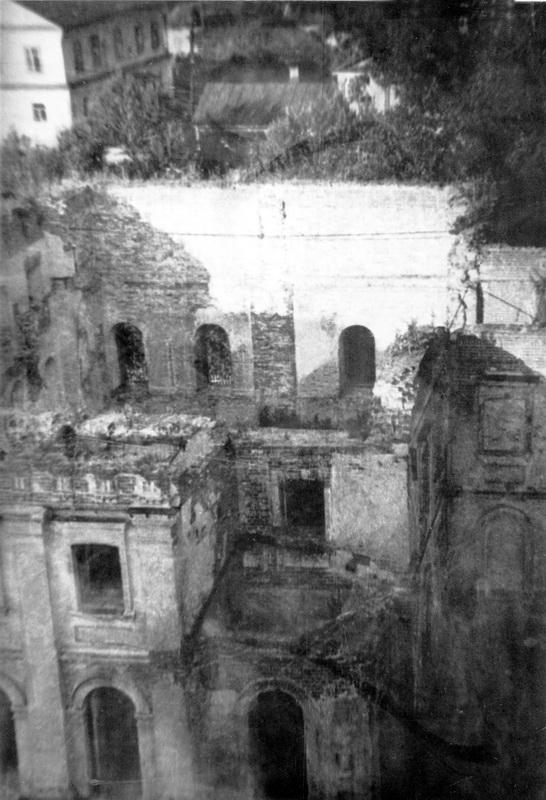 Views of the Entrance of the Theotokos Cathedral and the Church of St. Mary of Egypt before their restoration
Views of the Entrance of the Theotokos Cathedral and the Church of St. Mary of Egypt before their restoration
The Optina Hermitage was a rather sad sight decades after its closure. The Church of the Vladimir Icon of the Mother of God was completely destroyed, as was the necropolis. Only small sections of the old monastery paths remained, along which you could imagine with great difficulty the former appearance of the monastery territory, and more so—individual graves. It’s quite understandable how difficult it was after such devastation to search for the dear graves of the Elders on the monastery necropolis.
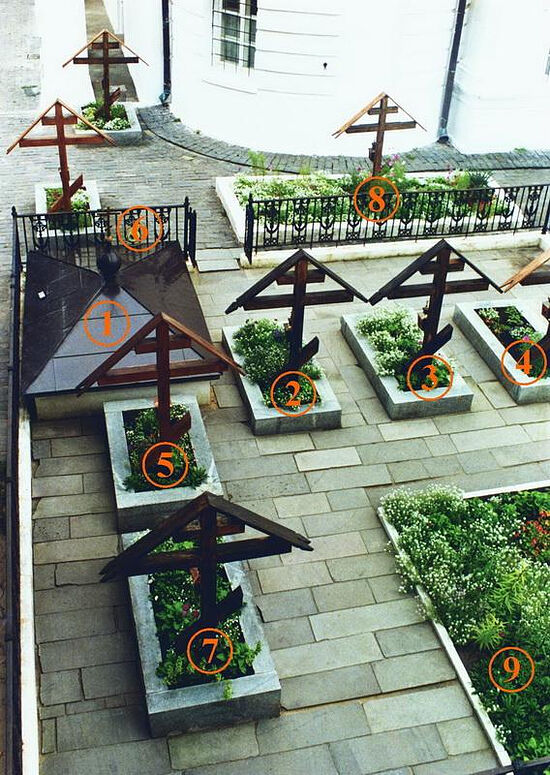 A: This is how the restored monastery necropolis looked up to July 7, 1998. It was believed that the graves were located as follows: (1) former burial site of Elder Ambrose; (2) grave of Elder Macarius; (3) grave of Elder Leo; (4) grave of Alexei Zhelyabuzhshky; (5) or (6) grave of Elder Anatoly (Potapov); (7) grave of Elder Joseph; (8) a common grave for the brethren whose remains were moved to build the St. Nicholas altar; (9) burial site of the Kireevsky brothers
A: This is how the restored monastery necropolis looked up to July 7, 1998. It was believed that the graves were located as follows: (1) former burial site of Elder Ambrose; (2) grave of Elder Macarius; (3) grave of Elder Leo; (4) grave of Alexei Zhelyabuzhshky; (5) or (6) grave of Elder Anatoly (Potapov); (7) grave of Elder Joseph; (8) a common grave for the brethren whose remains were moved to build the St. Nicholas altar; (9) burial site of the Kireevsky brothers
Since there was some disagreement about the location of the Elders’ graves, only excavations at the sites of the saints’ burial could clarify the situation, and that meant nothing other than the uncovering of their holy relics. It was necessary to carefully prepare for such an important matter, and first of all, to determine a worthy place where the uncovered relics would be placed for veneration. The restored Church of the Vladimir Icon of the Mother of God was wonderfully suited for this. Having received the blessing of His Holiness Patriarch Alexei, the work of uncovering the holy relics of the Elders buried on the monastery necropolis began on July 7, 1998.
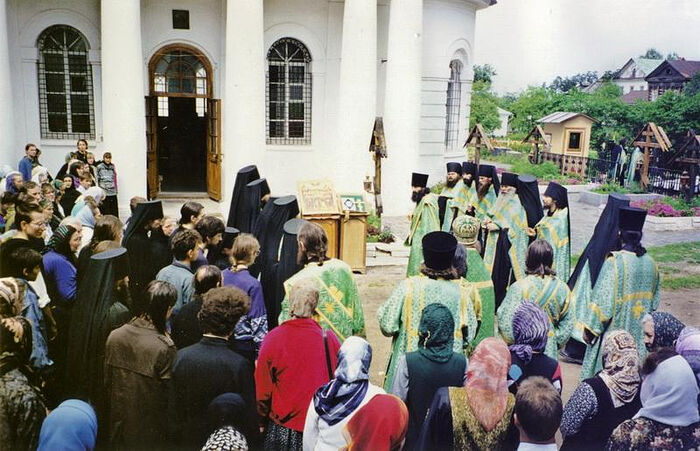 Moleben before the start of the work, July 7, 1998
Moleben before the start of the work, July 7, 1998
On July 8, on the day of the repose of St. Nikon of Optina, the clergy went out to the necropolis, and a censing and magnification of the Synaxis of Optina Elders were served.
A tent can be seen over the site where they were working on uncovering the relics of the venerable Elders Anatoly (Zertsalov) and Barsanuphius.
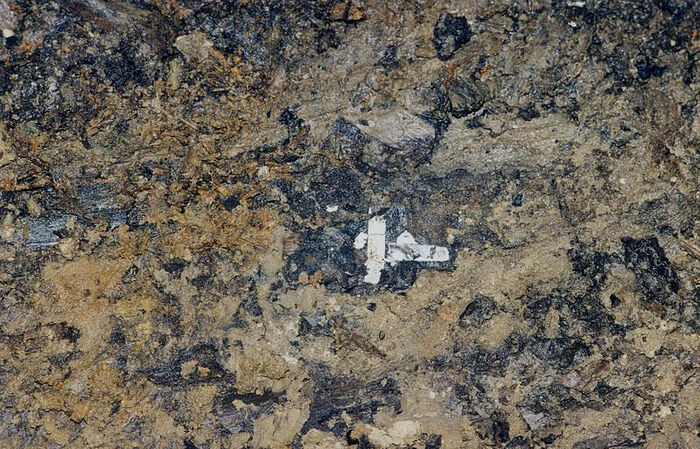 The cross on the relics of Elder Barsanuphius
The cross on the relics of Elder Barsanuphius
No one ever had any doubts about the burial place of Elders Anatoly (Zertsalov) and Barsanuphius. The preserved photos gave clear and accurate landmarks for the site. Additionally, excavations were previously carried out on this site, and the boundaries of the crypts where these two Elders were buried were found. Thus, the work that began on July 7, 1998, was completed successfully, and the relics of Elders Anatoly (Zertsalov) and Barsanuphius were uncovered without any particular difficulty.
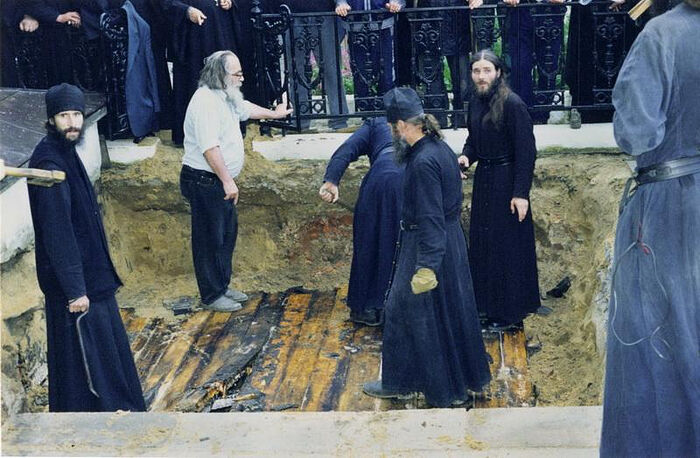 Wooden covering over the supposed crypts of Elders Leo and Macarius after their first excavation in 1990
Wooden covering over the supposed crypts of Elders Leo and Macarius after their first excavation in 1990
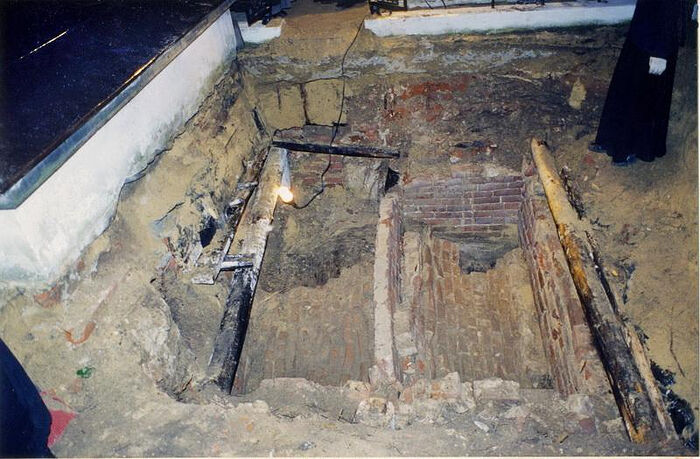 After removing the wooden covering, two crypts with collapsed vaults could be seen
After removing the wooden covering, two crypts with collapsed vaults could be seen
The question of where to begin the work on the necropolis behind the altar of St. Nicholas never arose, because if we assume that the relics of St. Ambrose uncovered in 1988 truly belong to him, then as is clearly seen on all the preserved photos and from all the published testimonies, to the left of his grave should be the crypt of Elder Macarius, and behind him—Elder Leo (see (2) and (3) in picture B).
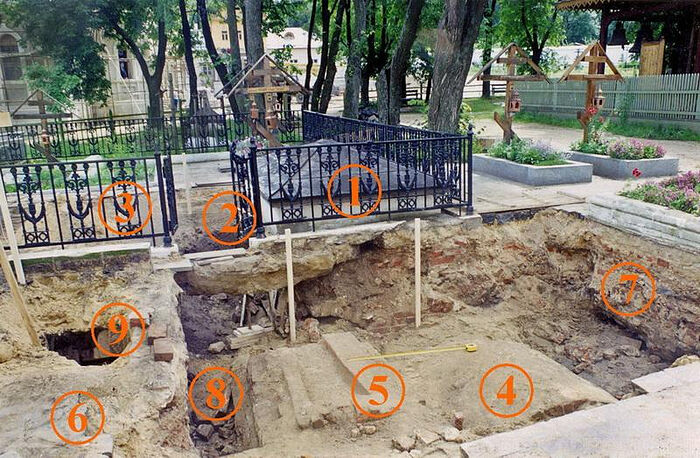 B: View of the excavation site from west to east: (1) crypt from which in 1998, remains were found which until July 7, 1998, were believed to be those of St. Ambrose; (2) the site believed to be the grave of Elder Macarius until July 8, 1998; (3) the site believed to be the grave of Elder Leo until July 7, 1998; (4), (5), (6), (7) the crypts located one row closer to the St. Nicholas altar of the Entrance of the Theotokos Cathedral; (8) the site where they began to see for the grave of Elder Leo; (9) opening in a large transverse (from south to north) crypt (6) (also see (8) in picture A)
B: View of the excavation site from west to east: (1) crypt from which in 1998, remains were found which until July 7, 1998, were believed to be those of St. Ambrose; (2) the site believed to be the grave of Elder Macarius until July 8, 1998; (3) the site believed to be the grave of Elder Leo until July 7, 1998; (4), (5), (6), (7) the crypts located one row closer to the St. Nicholas altar of the Entrance of the Theotokos Cathedral; (8) the site where they began to see for the grave of Elder Leo; (9) opening in a large transverse (from south to north) crypt (6) (also see (8) in picture A)
Additionally, there had already been excavations at the supposed burial place of Elders Leo and Macarius, and two collapsed crypts were discovered, although out of a sense of deep reverence for the Elders, no one dared touch them. A solid wooden cover was built over them, covered with waterproof roofing material, and then they were covered with dirt again.
On the same day, July 7, 1998, literally fifteen to twenty minutes after the excavation began, everyone saw this previously made covering. When they removed it and cleared away the dirt, two crypts with collapsed vaults could be seen. In the course of further work, carried out with extreme care and attention, the very well-preserved remains of two laymen were found in these crypts. In the north crypt was a coffin lined with zinc, with the body of a layman, dressed in a long cloak or service uniform, feet shod in leather boots. There were still metal buttons on his clothes, and a collar of secular clothing around his neck. The arms of the reposed lay not on his chest, but along the body; the narrow sleeves of secular clothing were well preserved. Looking somewhat in profile, we as if see a portrait of Ivan Kireyevsky, with his characteristic beard, with almost no hair on the middle of his chin. The zinc-lined coffin most likely belongs to him, since his body had been brought from St. Petersburg, where he died of cholera. It’s also known that the Kireyevskies were buried near the graves of Elders Leo and Macarius.
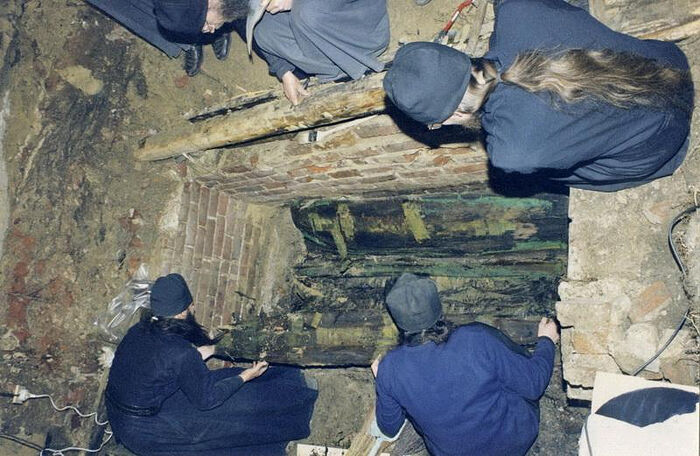 The coffin lined with zinc sheets
The coffin lined with zinc sheets
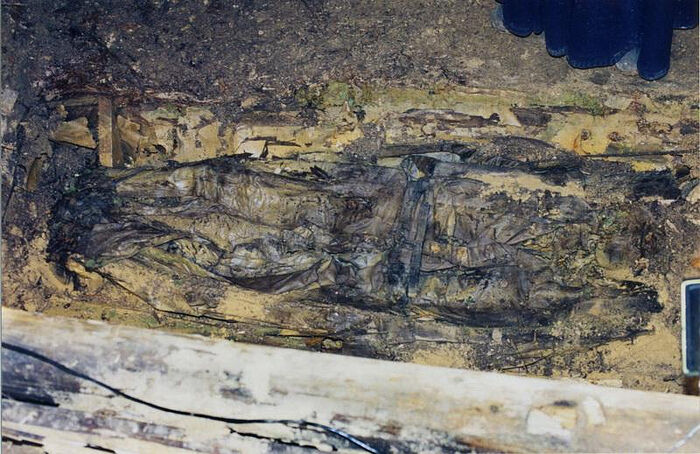 In the coffin are the remains of a layman—Ivan Kireyevsky by all indications
In the coffin are the remains of a layman—Ivan Kireyevsky by all indications


